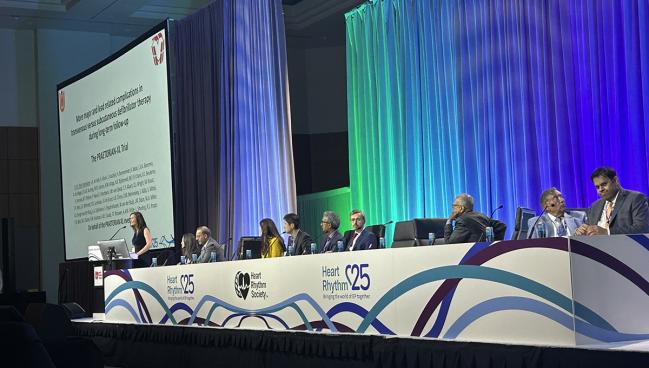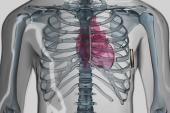PRAETORIAN-XL: Fewer Major, Lead-Related Problems With Subcutaneous ICD
The choice between ICD types still should be based on each individual patient’s risk factors, Kenneth Ellenbogen says.

SAN DIEGO, CA—Use of a subcutaneous implantable cardioverter-defibrillator (S-ICD) appears to have some advantages over transvenous devices for patients with an ICD indication but no need for pacing, according to extended follow-up of the PRAETORIAN trial.
In PRAETORIAN-XL, investigators tracked patients from the original trial for an additional 4 years, bringing the total follow-up time to about 8 years. Over that span, there was no significant difference in the rate of all device-related complications between the Emblem S-ICD (Boston Scientific) and transvenous groups (8.0% vs 11.6%; HR 0.73; 95% CI 0.48-1.12).
As Louise Olde Nordkamp, MD, PhD (Amsterdam UMC, the Netherlands), reported recently at Heart Rhythm 2025, however, rates of major and lead-related complications significantly favored the subcutaneous device. Mortality, heart failure hospitalization, and MACE risks did not differ between arms.
Based on the results, published simultaneously online in Circulation, “we conclude that the subcutaneous ICD should be strongly considered in all patients without a pacing indication who are evaluated for ICD therapy,” Olde Nordkamp said, adding that younger patients are strongly advised to opt for the S-ICD.
Ultimately, though, the patients make the decision. “What we do is we really tell the patient about both devices, and we tell them all the advantages and all the disadvantages of both devices,” she said. “We show them the devices, and we actually let them choose between the subcutaneous or transvenous ICD.”
Heart Rhythm Society President Kenneth Ellenbogen, MD (Virginia Commonwealth University, Richmond), did not agree that there should be a strong blanket preference for the subcutaneous option. He noted that putting in a transvenous ICD is a very simple and relatively quick procedure that is often performed with the patient under conscious sedation. On the other hand, many electrophysiologists will implant the S-ICD with the patient under general anesthesia, and the procedure takes longer.
Moreover, Ellenbogen said, a “not insignificant” percentage of patients receiving an ICD will develop pacing indications over time.
He estimated that at most centers, only 5% to 10% of ICD patients are receiving a non-transvenous device, adding, “Although this study is important and well done, I don’t think it’s going to move the needle very much.”
PRAETORIAN-XL
The Emblem S-ICD was developed to provide an alternative to transvenous systems, which come with a risk of lead-related complications. Early on, there were concerns about increased numbers of inappropriate shocks due to oversensing with the subcutaneous device, although these have since been addressed by better programming and new software algorithms, Olde Nordkamp said. At the same time, programming changes have reduced inappropriate shock rates in transvenous ICDs as well.
In the original PRAETORIAN trial, which included patients with a class I or IIa ICD indication and no need for pacing, the S-ICD was noninferior to transvenous ICDs for a combined endpoint of complications and inappropriate shocks through about 4 years of follow-up.
But problems with the leads, particularly lead failures and infections, along with device-related complications in general, will continue to accrue during long-term follow-up, Olde Nordkamp said.
Thus, the investigators followed consenting patients who completed the PRAETORIAN trial for an additional 4 years for the PRAETORIAN-XL study; about 80% agreed to continue (median 7.3 years). Median age at ICD implantation was 63 years in the S-ICD arm and 64 years in the transvenous ICD arm, and about 20% of participants were women. Nearly one-fifth had a secondary prevention indication.
The primary endpoint consisted of all major and minor device-related complications, which included infection, hematoma, thrombotic events, pneumo- or hemothorax, cardiac perforation or tamponade, lead repositioning or replacement, and other device-related complications. The difference between groups was not significant over extended follow-up, with a notable bump in the rate around 5 to 6 years in the S-ICD arm. Olde Nordkamp said this was mostly attributed to generator changes, noting that the trial involved first-generation S-ICDs with a battery life of about 5 to 7 years. In addition, implanters had limited experience with the devices.
Secondary endpoints indicated an advantage for the S-ICD, however, with lower rates of major complications requiring an invasive intervention (5.7% vs 10.2%; HR 0.58; 95% CI 0.36-0.95) and lead-related complications (2.4% vs 8.3%; HR 0.33; 95% CI 0.17-0.63).
Crossovers to other implanted devices occurred in 12% of the S-ICD group and 10% of the transvenous group, most commonly for progression of heart failure. Olde Nordkamp noted that a high proportion of the complications in the S-ICD group (23%) occurred after the patients had crossed over to receive either a transvenous ICD or cardiac resynchronization therapy-defibrillator (CRT-D).
In an as-treated analysis to account for crossovers, the rate of all device-related complications was significantly lower with subcutaneous versus transvenous ICDs (9.1% vs 13.3%; HR 0.64; 95% CI 0.41-0.99).
Individualize the Decision
One of the presumed advantages of the S-ICD was that there would be fewer inappropriate shocks, “but that didn’t actually turn out to be true,” Ellenbogen said, pointing out that the software in transvenous ICDs improved greatly.
While “it’s probably true if you wait 8 or 9 years, that patients may tend to have a little bit more lead-related problems with transvenous ICDs, but it’s such a moving target,” he added. “The transvenous leads are getting better and more reliable over time, the algorithms are getting better, and there haven’t been, over the last 3 or 4 or 5 years, any new advances in [S-ICD] algorithms to avoid inappropriate shocks.”
The bottom line, Ellenbogen said, is that “the decision about what type of ICD to implant still has to be very much based upon the risk factors in an individual patient.” Young patients with genetic cardiomyopathies or patients with vascular abnormalities or a very high risk for infection, for example, are good candidates for the S-ICD, he noted.
Todd Neale is the Associate News Editor for TCTMD and a Senior Medical Journalist. He got his start in journalism at …
Read Full BioSources
Olde Nordkamp LRA, de Veld JA, Ghani A, et al. Device-related complications in transvenous versus subcutaneous defibrillator therapy during long-term follow-up: the PRAETORIAN-XL trial. Circulation. 2025;Epub ahead of print.
Disclosures
- PRAETORIAN-XL was funded by Boston Scientific.
- Olde Nordkamp reports no relevant conflicts of interest.





Comments